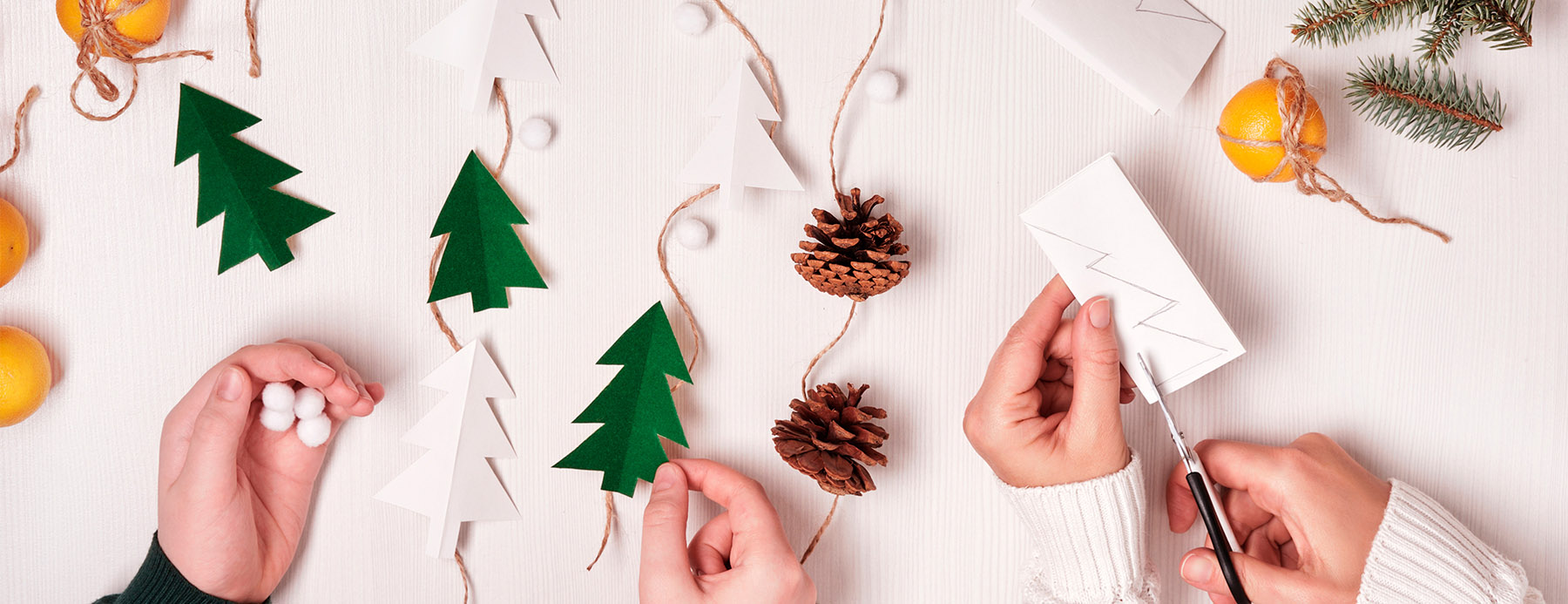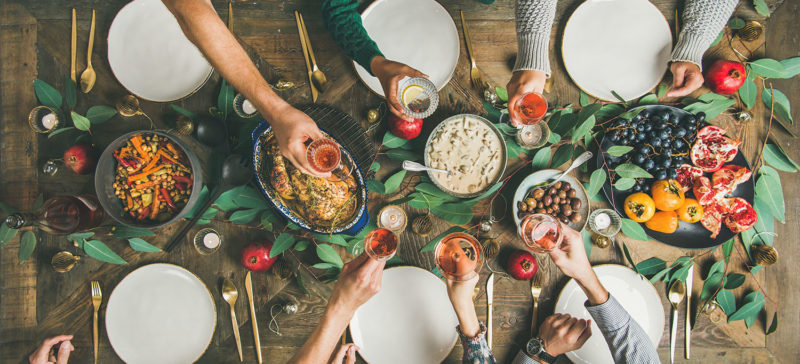

A sustainable Christmas is in our hands
Has sentit mai l’expressió “Va més guarnit que un arbre de Nadal”? Quan arriben les festes nadalenques, sembla que tot canvia d’aspecte. Els carrers, les botigues, els monuments, les places i les cases s’omplen de decoracions diverses. Però ens hem parat a pensar si tot aquest ritual pot ser una mica més sostenible?
Arbres, cintes, boles, mitjons, llums, figuretes, garlandes, canelobres… Cada any, a principis de desembre, llums i colors s’escampen arreu de la geografia dels països que celebren Nadal. L’encesa dels llums en espais públics s’ha convertit en un ritual social, però també és un ritual per moltes llars dedicar un temps a decorar espais amb elements nadalencs.
Encara que el plàstic continua liderant el material amb el qual estan fetes les decoracions nadalenques, els darrers anys el model de societat d’un sol ús sembla que es comença a posar en dubte. És amb aquesta exigència que els elements naturals cada vegada són més presents a les fires i són una bona alternativa.
Els elements naturals, a més, un cop acabades les festes, són 100% compostables i es descomponen en un espai curt de temps. D’altra banda, si a les moltíssimes fires que hi ha al país no trobes el que busques, sempre hi ha l’opció de fer-los tu mateix, amb el que tens per casa i t’ofereix la natura. Amb una mica d’imaginació s’aconsegueixen fer ornaments únics!
Arbre, garlandes i boles, ‘Do it yourself’
Si bé és cert que tenir un arbre de Nadal artificial, que es pot guardar i tornar a col·locar l’any següent, algú ho pot considerar una pràctica sostenible, perquè el reutilitzes, també és cert que acostuma a ser de plàstic, i, per tant, tardarà uns 400 anys a descompondre’s. D’altra banda, solen ser fabricats a l’altra punta del món i el seu transport ja suposa una petjada de carboni important.
Atenent tots aquests punts, els arbres de Nadal naturals són una de les opcions a tenir en compte. La seva venda està regulada, són de proximitat i els ajuntaments acostumen a fer una recollida passades les festes. La majoria els reciclen, convertint-los en algunes ocasions en compostatge. Una altra alternativa és fer ús de la imaginació i fer un arbre de Nadal amb materials naturals com ara fustes, cordes, palets, cintes, etc.
El mateix passa amb les garlandes i les boles de decoració dels arbres. Acostumen a fer-se amb material plastificat. Tenim alternatives més naturals, com les boles i garlandes fetes amb roba, llana, fruita natural (amb pells de taronja i llimona assecades, que a més aromatitzen l’ambient). A internet trobareu molts tutorials de com fer-ne.
Corones i centres de taula
Les corones de Nadal que es pengen a la porta també poden ser fetes per un mateix. Amb filferro, ferments, cartó, podem fer la circumferència que després podem cobrir amb pinyes, peles de cítrics seques, glans, nous, branquillons d’avet, boles i cors de feltre, de roba, de paper, etc. Podem pintar o no els diferents elements amb colors daurats, coure, vermell i platejat; i posar-hi cintes de colors, com ara blaves, vermelles, daurades i platejades.
Nadal és temps de trobada. Els àpats són un dels moments més rellevants de les festes. Els dinars de Nadal i Sant Esteve, el sopar de Cap d’Any i el dia de Reis són ocasions que requereixen una atenció especial en el parament de la taula.
En ocasions especials, una vegada més, tenir cura dels detalls és important i fer servir vaixella i coberteria d’un sol ús ens pot alleugerir la feina, però també ens suposa fer un munt de deixalles i que l’ocasió perdi glamur: el menjar no té el mateix gust si se serveix amb plat de paper que amb vaixella de porcellana; i tampoc tastarem igual el vi, ni l’aigua.
Així que, si podem, sempre és millor fer servir coberts de metall, vaixella de ceràmica o porcellana i copes i gots de vidre o cristall. Una bona vaixella, també es mereix unes bones tovalles i tovallons i, si són de cotó o lli, millor que de paper o plastificades. I, per donar a la taula un toc personal, es pot decorar el centre fent un camí amb branquetes d’avet natural i espelmes que no siguin perfumades, pinyes, fruits secs, etc. Res de centres alts, que ens privarien de veure el convidat del davant!
Embolcalls de regals: la ‘furoshiki’
Cadascú de nosaltres, segons dades de l’Idescat, generem 1,44 quilos de deixalles diàries. Per Nadal, els residus generats per la ciutadania augmenten un 3%, segons dades de l’Agència de Residus de Catalunya. Les restes de menjar, de vidre i de paper i cartó són les que augmenten més. Per això, és important calcular bé les quantitats de menjar i pensar bé els regals que es fan. Si els regals són útils o intangibles (entrades a espectacles, concerts, massatges, subscripcions, etc.), el volum de deixalles es redueix.
Els embolcalls dels regals també representen una generació extra de residus. Per això, és crucial ser, també, creatius a l’hora d’embolicar els regals. Hi ha moltes maneres de fer-ho, des de fer ús de paper de revistes i diaris, fins a reutilitzar paper d’altres regals. I, una manera innovadora és fent servir un mètode japonès, conegut com a ‘furoshiki’.
La ‘furoshiki’ és una tela quadrangular tradicional del Japó, que es fa servir per embolicar i transportar objectes, des de roba, ampolles i regals. Vindria a ser com un mocador de fer farcells. El regal és embolcallat amb aquest mocador i el que el rep el pot reutilitzar per embolicar un altre regal. Fins i tot, pot ser que torni a les teves mans embolcallant un regal!
Una altra manera de reduir residus és regalar algun objecte que no fem servir. Per fer l’amic invisible és una bona idea: el que tu no fas servir o no t’agrada li pot agradar a una altra persona. Aconseguir que Nadal, una de les èpoques més consumistes i generadores de residus de l’any, sigui sostenible està, també, a les nostres mans.
11Onze és la fintech comunitària de Catalunya. Obre un compte descarregant la super app El Canut per Android o iOS. Uneix-te a la revolució!





👏
Aprofitem i reutilitzem quan podem. L’important és a l’interior del regal.
Si, és més especial saber que la persona que t’ho regala ha estat un temps per embolicar-ho i els detalls que hi posi i com ben dius l’important és a l’interior. Bones Festes!
Està molt bé aquesta manera de fer paquets al Japó.
Doncs sí, sempre aprenem coses noves. Moltes gràcies pel teu comentari, Joaquim!!!
Quina bona idea l’embolcall com un mocador de farcell, m’ha encantat
🙏
👌
Gràcies, Joan!!!
Suggeriments interessants. Per a mi els “furoshiki” són un invent importable que m’agrada
Gràcies, Francesc, seguim aprenent. Ens veiem per la Plaça
Benvingut de nou l’ arbre de Nadal a casa. No vaig entendre mai que es substituís pel de plàstic en nom d’una més que errònia argumentació de que no es podien tallar arbres. Per qui tingui vinyes a la vora : Els ceps morts decorats són ideals com ornament nadalenc. Si són grossos inclús poden substituir l’arbre. Benvinguts també els jocs de taula de lli i cotó , i les vaixelles de pedra o porcellana i les copes i gots de vidre o cristall. El problema es clar, és que hi ha més feina a rentar, planxar. Però una bona festa s´ho mereix.
És un bon punt de vista i una encertada opinió, la teva, i a partir d’aquí que cadascú faci el que li sembli. Moltes gràcies pel teu comentari, Mercè, i que gaudeixis del Nadal i de les festes.